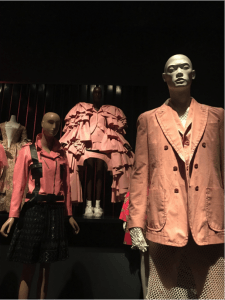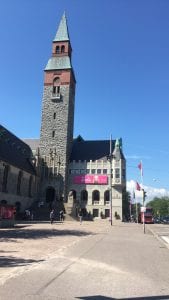MA History of Design and Material Culture student Emmy Sale on an unknown photo album from the University of Brighton Dress History teaching collection

Fig 1: Photo album with photographs dating between 1936 and 1949. University of Brighton Dress History Teaching Collection. Photograph by author.
The Dress History teaching collection is home to a number of photo albums with unknown provenance. This album (Figure 1) has a faux leather cover with an embossed black border. The pages are thick brown paper, photographs mounted with corner tabs. It contains images dating from 1936 to 1949, with locations around Britain and abroad, showing that the family who made it travelled regularly.
When analysing the album I had the feeling, described by photography curator Verna Curtis, that ‘when you hold a photo album, you sense that you are in possession of something unique, intimate and meant to be saved for a long time. As you turn the pages and look at the images, you imbibe the maker’s experience, invoking your imagination and promoting personal memories’.[i] Inside the album are images of the family’s holiday to Clovelly, Devon. The village is near my hometown so these created an immediate connection between me and this unknown family’s past.

Fig 2: Woman riding a Donkey at the Clovelly estate, Devon. Undated. University of Brighton Dress History Teaching Collection. Photograph by author.
In one of the Clovelly images (Figure 2) there is a woman in the side of the shot passing a Box Brownie to someone. Although the first amateur cameras available were the Kodak No.1 roll film cameras in 1888, these were expensive and often only a toy for the upper and middle classes. It was not until the 1920s that lower class families were able to purchase photography equipment such as the Box Brownie, which cost 5 shillings in 1900. The original Brownie took images of a 57 millimetre square but the Brownie No.2 took photos sizing 57 by 83 millimetres, the proportions of the images in this album. Therefore, it is likely that a Box Brownie 2 was used to take the photographs whilst revealing that this camera was an affordable option for many lower class families in the 1930s, to capture images of day trips and holidays.

Fig 3: Three women sitting on Clacton Beach. 1936. University of Brighton Dress History Teaching Collection. Photograph by author.
The photographs from this album can be used as a source in dress history research. The images provide evidence of what people wore for special occasions or vacations, they show how garments were worn and what they were paired with. For example, images can be used to make sense of isolated garments in archives or even see garments that have not survived. However, the image of three young women on Clacton beach in 1936 (Figure 3), proves how difficult it can be to identify class differences in photographs due to the widespread mass consumption of clothing. It is difficult to tell from the photograph whether the bathing suits worn are expensive Jantzen suits that cost at least fifteen shillings in 1936 or a garment knitted at home with the use of patterns provided in two-penny papers. The exact details of the garments’ manufacture are locked within the photograph and would need the use of oral testimony from one of those photographed to identify them.
Although the use of unknown photographs in dress history can be down to interpretation, with persistence it can lead to the discovery of an aspect of the photograph’s narrative. This can be about the sitters’ lifestyle, their dress, or simply how the photograph was made. In my own research on knitted bathing suits in the 1930s, they have provided insight by showing how bathing suits were worn on the body and the ways in which wearers would imitate poses of glamorous images they saw in magazines. Such readings have lead to a questioning of how young women regarded their bathing suits and its role in the social aspects of beach leisure. The survival of these images is pivotal to this research because there are only a few hand-knitted garments that have survived and video recordings of beach scenes only show those wealthy enough to afford it. Although the Box Brownie camera was still a luxury to some, it was an increasingly accessible mode of photography and therefore the images provide a source that shows the ordinary life of people and what they wore.
[i]Posever Verna Curtis, Photographic Memory: The Album in the Age of Photography(New York: Aperture, 2011) 7.


















